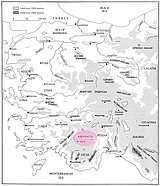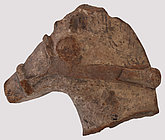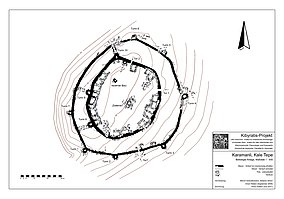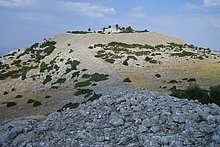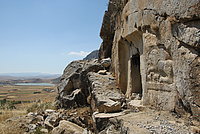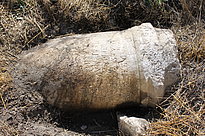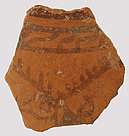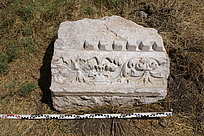The ancient Kibyratis in southwest Asia Minor is one of the most interesting, yet little studied areas in Turkey, as it is situated at the political and cultural intersection of numerous peoples like the Lydians, Lycians, Phrygians, Pisidians or Carians.
THE KIBYRATIS-PROJECT
sponsored by

Building on the long-standing epigraphic studies of Thomas Corsten an interdisciplinary field project started in 2008 with the aim of exploring the regional settlement patterns and the material culture.
Supported from the outset by the Gerda Henkel Stiftung, this project is undertaken in a collaboration of the Institute of Classical Archaeology of the Ludwig-Maximilians University of Munich and the Department of Ancient History, Papyrology and Epigraphy of the University of Vienna and is conducted by Dr. Oliver Hülden and Univ. Prof. Dr. Thomas Corsten.
The research area is named after the ancient city of Kibyra, and roughly comprises the western part of the Province of Burdur in Southwest Turkey. From a chronological point of view, most interesting are here the periods of significant changes in the historical development, such as the integration of the region into the Lydian Kingdom or into the Persian Empire in the second half of the 6th century B.C.
Other crucial moments in the area´s history include the probable expansion of Lycian territory under Perikle of Limyra in the first half of the 4th century B.C., followed by the increased political influence of the Hekatomnides and finally the foundation of the city of Kibyra (Strabon 13, 4, 17), which was obviously initiated by the Pisidians in the (late?) 3rd century B.C. All of these periods deserve closer scrutiny. The integration of the Kibyratis into the Roman Empire in the 1th century B.C. forms another focal point of our research.
Following an initial campaign in 2008 three major archaeological sites, which have not yet been studied in detail, were chosen for comprehensive documentation. The surrounding areas were also subject of intensive surface surveys (Video).
“Old-Kibyra”, the city´s Lydian predecessor according to Strabon has been identified with the settlement on the peninsula in Lake Gölhisar in a distance about 10 km from Kibyra, including a large necropolis and a densely populated hinterland. The most spectacular finds from the archaic period are a limestone fragment of a sculpture of a bird of prey, the head of a small terracotta horse and terracotta panelling, which all point to the existence of an important sanctuary.
The date of the roughly circular hill top fortification of Karamanlı is not yet known. The site is located close to the centre of the research area on the top of the hill Kale Tepe, a substantial part of which has already been removed due to activities by a modern stone quarry. The fortification may be related to the Hellenistic-Roman settlement of Alassos (the name is known from inscriptions) at the foot of the hill, which is overbuilt by the modern village of Karamanlı.
In the course of the surveys southwest of Karamanlı two long-known roman rock-cut sanctuaries near Tefenni were explored in more detail. One of the sanctuaries was dedicated to the local rider-god Herakles-Kakasbos, the other to the Dioskuroi. 14 new rock reliefs were discovered, including one peculiar depiction of the Dioskuroi.
In the northern part of the research area there is a fortified site at the hill top overlooking Lake Salda near Yeşilova. The site has an unusual plan and is still little known. It can be dated to the archaic period. A massive ringwall completely encloses the plateau which is additionally protected by an 800 m long barrier in the Southeast. In the northern part of the enclosure there is a separate and specially fortified castle area.
Selected Publications
Th. Corsten, Die Inschriften von Kibyra, Inschriften griechischer Städte aus Kleinasien 60 (Bonn 2002).
Th. Corsten, Kibyra und Lykien, in: Chr. Schuler (Hrsg.), Griechische Epigraphik in Lykien. Eine Zwischenbilanz, Akten des internationalen Kolloquiums München, 24.–26. Februar 2005, 25. Ergbd. TAM (Wien 2007) 175–181.
Th. Corsten, City and Country in the Kibyratis: A Case Study in Rural Acculturation, in: K. Dörtlük u. a. (Hrsg.), The IIIrd International Symposium on Lycia, 07–10 November 2005, Antalya, Symposium Proceedings I (Antalya 2006) 139–144.
Th. Corsten – Th. Drew-Bear – M. Özsait, Forschungen in der Kibyratis, EpigrAnat 30, 1998, 47–80.
Th. Corsten – O. Hülden – J. Gebauer, Research in the Kibyratis in 2009, AnadoluAkden 8, 2010, 143-147. [PDF zum Download]
Th. Corsten – O. Hülden, Research in the Kibyratis in 2010, AnadoluAkden 9, 2011, 180-183. [PDF zum Download]
Th. Corsten – O. Hülden – J. Gebauer, Research in the Kibyratis in 2011, AnadoluAkden 10, 2012 (im Druck).
K. A. Gay – Th. Corsten, Lycian Tombs in the Kibyratis and the Extent of Lycian Culture, AnatSt 56, 2006, 47–60.
O. Hülden, Bubon. Archäologische Untersuchungen im Stadtgebiet und im Umland, in: Chr. Kokkinia (Hrsg.), Boubon. The Inscriptions and Archaeological Remains. A Survey 2004–2006, ΜΕΛΕΤΗΜΑΤΑ 60 (2008) 133–178. [Rezension: N. P. Milner in: Bryn Mawr Classical Review 2009.09.5]
S. Japp, The Local Pottery Production of Kibyra, AnatSt 59, 2009, 95–128.

